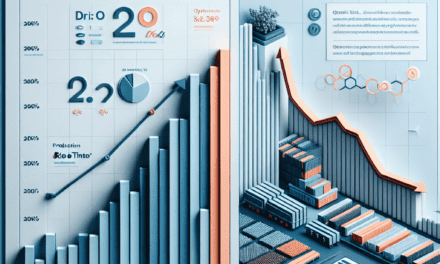“Brace for Impact: S&P 500 Faces Predicted 5% Dip, Says Technical Analyst”
Introduction
In recent market analyses, a prominent technical analyst has forecasted a potential 5% decline for the S&P 500 in the coming weeks. This prediction is based on a combination of chart patterns, historical data, and current market indicators that suggest a bearish trend may be on the horizon. As investors closely monitor these developments, the anticipated downturn could have significant implications for portfolios and investment strategies. The analyst’s insights provide a critical perspective on the market’s trajectory, urging stakeholders to prepare for possible volatility and adjust their positions accordingly.
Understanding the Technical Analysis Behind the Predicted S&P 500 Decline
In the realm of financial markets, technical analysis serves as a crucial tool for investors seeking to predict future price movements based on historical data. Recently, a prominent technical analyst has forecasted a 5% decline for the S&P 500 in the upcoming weeks, a prediction that has garnered significant attention. To comprehend the basis of this forecast, it is essential to delve into the intricacies of technical analysis and the specific indicators that have led to this conclusion.
Technical analysis primarily involves the study of price charts and trading volumes to identify patterns and trends. One of the key indicators often employed by analysts is the moving average, which smooths out price data to identify the direction of a trend. In this case, the analyst has observed that the S&P 500’s short-term moving average is poised to cross below its long-term moving average, a phenomenon known as a “death cross.” Historically, this pattern has been associated with bearish market sentiment, suggesting that a decline may be imminent.
Moreover, the analyst has pointed to the Relative Strength Index (RSI), a momentum oscillator that measures the speed and change of price movements. The RSI is currently indicating that the S&P 500 is approaching overbought territory, a condition that often precedes a market pullback. When the RSI reaches such levels, it implies that the market may have risen too quickly and could be due for a correction as investors begin to take profits.
In addition to these indicators, the analyst has highlighted the importance of support and resistance levels in predicting market movements. Support levels are price points where a downward trend is expected to pause due to a concentration of demand, while resistance levels are where an upward trend may stall due to a concentration of supply. The S&P 500 is currently nearing a significant resistance level, which has historically acted as a barrier to further gains. If the index fails to break through this level, it could trigger a reversal, leading to the anticipated decline.
Furthermore, the analyst has considered the broader macroeconomic environment, which can influence market sentiment and technical indicators. Recent economic data suggests potential headwinds, such as rising interest rates and geopolitical tensions, which could exacerbate the technical signals pointing towards a downturn. These factors contribute to a cautious outlook, reinforcing the prediction of a 5% decline.
While technical analysis provides valuable insights, it is important to acknowledge its limitations. Market movements are influenced by a myriad of factors, and no single method can guarantee accurate predictions. Nevertheless, by combining technical indicators with an understanding of the broader economic context, analysts can offer informed forecasts that aid investors in making strategic decisions.
In conclusion, the prediction of a 5% decline in the S&P 500 is grounded in a comprehensive analysis of technical indicators, including moving averages, the RSI, and support and resistance levels. Coupled with an awareness of macroeconomic conditions, these tools provide a framework for anticipating market trends. As investors navigate the complexities of the financial markets, such analyses serve as a valuable resource, offering guidance in an ever-evolving landscape.
Historical Context: How Accurate Are Technical Analysts in Predicting Market Trends?
Technical analysts have long been a fixture in the financial markets, offering insights based on chart patterns, historical data, and statistical indicators. Their predictions often capture the attention of investors and traders alike, especially when they forecast significant market movements. Recently, a technical analyst predicted a 5% decline for the S&P 500 in the upcoming weeks, prompting a closer examination of the historical accuracy of such forecasts. Understanding the reliability of technical analysis requires delving into its past performance and the methodologies employed by analysts.
Historically, technical analysis has been both praised and criticized for its predictive capabilities. Proponents argue that it provides a systematic approach to understanding market psychology and price movements, while critics contend that it relies too heavily on past data, which may not always be indicative of future trends. Despite these differing viewpoints, technical analysis has demonstrated a degree of accuracy in certain market conditions. For instance, during periods of high volatility or when clear patterns emerge, technical analysts have successfully anticipated market shifts. However, it is crucial to recognize that these predictions are not infallible and are often subject to external factors that can alter market dynamics.
One of the key strengths of technical analysis lies in its ability to identify trends and reversals. By examining historical price data, analysts can detect patterns such as head and shoulders, double tops, and support and resistance levels. These patterns, when combined with indicators like moving averages and relative strength index (RSI), can provide valuable insights into potential market movements. Nevertheless, the accuracy of these predictions is contingent upon the analyst’s skill in interpreting the data and the prevailing market conditions. In some cases, technical analysis has been criticized for its subjective nature, as different analysts may interpret the same data in varying ways.
Moreover, the effectiveness of technical analysis can be influenced by the time frame under consideration. Short-term predictions may be more susceptible to noise and random fluctuations, whereas long-term forecasts might overlook immediate market catalysts. This variability underscores the importance of context when evaluating the accuracy of technical analysts’ predictions. It is also worth noting that technical analysis is often used in conjunction with other forms of analysis, such as fundamental analysis, to provide a more comprehensive view of the market.
In the case of the recent prediction of a 5% decline in the S&P 500, it is essential to consider the broader economic environment and any potential catalysts that could impact market sentiment. Factors such as interest rate changes, geopolitical events, and corporate earnings reports can all play a significant role in shaping market trends. Therefore, while technical analysis can offer valuable insights, it should not be relied upon in isolation.
In conclusion, the historical accuracy of technical analysts in predicting market trends is a nuanced topic. While technical analysis has proven effective in certain scenarios, its reliability is not absolute and is influenced by various factors, including the analyst’s expertise and external market conditions. As investors and traders assess the recent prediction of a 5% decline in the S&P 500, it is crucial to consider the broader context and integrate multiple analytical approaches to make informed decisions. Ultimately, technical analysis remains a valuable tool in the investor’s toolkit, but it should be used judiciously and in conjunction with other forms of analysis to navigate the complexities of the financial markets.
Key Indicators: What Signals a 5% Decline for the S&P 500?
In the ever-evolving landscape of financial markets, technical analysis serves as a crucial tool for investors seeking to anticipate future price movements. Recently, a prominent technical analyst has forecasted a potential 5% decline in the S&P 500 over the coming weeks. This prediction is grounded in a confluence of key indicators that suggest a bearish trend may be on the horizon. Understanding these signals is essential for investors aiming to navigate the complexities of the stock market with informed precision.
One of the primary indicators pointing towards a potential downturn is the relative strength index (RSI), a momentum oscillator that measures the speed and change of price movements. Currently, the RSI for the S&P 500 is hovering near overbought levels, typically considered a precursor to a market correction. When the RSI reaches such elevated levels, it often signals that the market is due for a pullback as buying momentum begins to wane. This overbought condition suggests that the recent rally may have been overextended, increasing the likelihood of a reversal.
In addition to the RSI, moving averages provide further evidence supporting the analyst’s prediction. The S&P 500 has recently experienced a “death cross,” a technical pattern that occurs when the short-term moving average crosses below the long-term moving average. This pattern is widely regarded as a bearish signal, indicating that downward momentum is gaining strength. Historically, the occurrence of a death cross has often been followed by a period of declining prices, reinforcing the notion that the market may be poised for a downturn.
Moreover, the analysis of trading volume adds another layer of insight into the potential decline. A divergence between price movements and trading volume can be a telling sign of an impending shift in market direction. In recent weeks, the S&P 500 has seen rising prices accompanied by decreasing volume, suggesting that the upward trend lacks the robust support of investor participation. This divergence indicates that the rally may be losing steam, as fewer investors are willing to buy at current levels, thereby increasing the risk of a reversal.
Furthermore, external macroeconomic factors cannot be overlooked when assessing the potential for a market decline. Ongoing concerns about inflationary pressures and interest rate hikes by central banks have created an environment of uncertainty. Such conditions often lead to heightened volatility in equity markets, as investors reassess their risk exposure. The interplay between these macroeconomic factors and technical indicators creates a complex backdrop that could exacerbate the predicted decline in the S&P 500.
While technical analysis provides valuable insights, it is important to acknowledge its limitations. Market predictions are inherently uncertain, and unforeseen events can quickly alter the trajectory of financial markets. Nevertheless, the convergence of these technical indicators presents a compelling case for caution among investors. By remaining vigilant and considering both technical and fundamental factors, investors can better position themselves to navigate potential market fluctuations.
In conclusion, the prediction of a 5% decline in the S&P 500 is supported by a range of technical indicators, including the relative strength index, moving averages, and trading volume analysis. Coupled with macroeconomic uncertainties, these signals suggest that a bearish trend may be imminent. As investors grapple with these insights, maintaining a balanced perspective and adapting to changing market conditions will be key to managing risk and optimizing investment strategies.
Investor Strategies: How to Prepare for a Potential S&P 500 Downturn

In the ever-evolving landscape of financial markets, investors are constantly seeking insights to navigate potential fluctuations. Recently, a prominent technical analyst has forecasted a 5% decline for the S&P 500 in the upcoming weeks, prompting investors to reassess their strategies. Understanding the implications of such predictions is crucial for those looking to safeguard their portfolios and capitalize on potential opportunities. As the S&P 500 serves as a barometer for the overall health of the U.S. stock market, any anticipated downturn warrants careful consideration and strategic planning.
To begin with, it is essential to comprehend the basis of the analyst’s prediction. Technical analysis involves evaluating statistical trends gathered from trading activity, such as price movement and volume. By examining historical data and chart patterns, analysts attempt to forecast future market behavior. In this instance, the analyst has identified specific indicators suggesting a potential decline, including overbought conditions and weakening momentum. While technical analysis is not infallible, it provides valuable insights that can guide investors in making informed decisions.
In light of this forecast, investors may consider several strategies to mitigate potential risks. Diversification remains a fundamental principle in managing investment portfolios. By spreading investments across various asset classes, sectors, and geographic regions, investors can reduce their exposure to any single market downturn. This approach not only helps in cushioning the impact of a decline in the S&P 500 but also positions investors to benefit from potential gains in other areas.
Moreover, investors might explore the use of hedging techniques to protect their portfolios. Options and futures contracts can serve as effective tools for mitigating downside risk. For instance, purchasing put options on the S&P 500 allows investors to profit from a decline in the index, offsetting potential losses in their equity holdings. However, it is important to note that hedging strategies can be complex and may involve additional costs, necessitating a thorough understanding before implementation.
In addition to diversification and hedging, maintaining a long-term perspective is crucial. Market fluctuations are an inherent part of investing, and short-term volatility should not deter investors from their overarching financial goals. Historically, the stock market has demonstrated resilience, with periods of decline often followed by recovery and growth. By focusing on a long-term investment horizon, investors can weather short-term downturns and potentially benefit from future market upswings.
Furthermore, staying informed and vigilant is paramount in navigating uncertain market conditions. Regularly reviewing and adjusting investment portfolios in response to changing market dynamics can help investors remain aligned with their financial objectives. Engaging with financial advisors or leveraging research from reputable sources can provide valuable insights and guidance during periods of market uncertainty.
In conclusion, while the prediction of a 5% decline in the S&P 500 may raise concerns, it also presents an opportunity for investors to reassess and refine their strategies. By embracing diversification, considering hedging techniques, maintaining a long-term perspective, and staying informed, investors can better position themselves to navigate potential downturns. Ultimately, a proactive and informed approach can empower investors to not only protect their portfolios but also capitalize on opportunities that may arise in the ever-changing financial landscape.
Market Volatility: What a 5% Decline Means for the Broader Economy
In recent weeks, the financial markets have been abuzz with discussions surrounding the potential for a 5% decline in the S&P 500, as predicted by a prominent technical analyst. This forecast has sparked considerable interest and concern among investors, economists, and policymakers alike, as they seek to understand the broader implications of such a downturn on the economy. To fully grasp the potential impact, it is essential to explore the interconnectedness of the stock market with various economic indicators and sectors.
The S&P 500, a benchmark index representing the performance of 500 of the largest publicly traded companies in the United States, serves as a barometer for the overall health of the stock market. A 5% decline in this index, while not unprecedented, can signal underlying vulnerabilities within the market. Such a drop may be indicative of investor sentiment shifting towards caution, often driven by factors such as geopolitical tensions, changes in monetary policy, or unexpected economic data releases. Consequently, this shift in sentiment can lead to a ripple effect across the broader economy.
One of the immediate consequences of a decline in the S&P 500 is the potential impact on consumer confidence. As stock prices fall, investors may experience a decrease in their portfolio values, leading to a perceived reduction in wealth. This phenomenon, known as the wealth effect, can result in consumers becoming more conservative with their spending habits. Reduced consumer spending, in turn, can have a dampening effect on economic growth, as consumer expenditures account for a significant portion of the Gross Domestic Product (GDP).
Moreover, a decline in the stock market can also affect corporate investment decisions. Companies may become more hesitant to embark on new projects or expand their operations if they perceive increased uncertainty in the market. This cautious approach can lead to a slowdown in capital expenditures, which are crucial for driving innovation and productivity improvements. As businesses scale back their investments, the potential for job creation may also diminish, further impacting economic growth.
In addition to affecting consumer and corporate behavior, a downturn in the S&P 500 can have implications for the financial sector. Banks and other financial institutions, which often hold significant equity positions, may face increased pressure on their balance sheets. This pressure can lead to tighter lending conditions, as financial institutions become more risk-averse. Consequently, businesses and consumers may find it more challenging to access credit, which can further constrain economic activity.
While a 5% decline in the S&P 500 may not constitute a full-blown market correction, it is essential to consider the broader context in which this decline occurs. If the downturn is accompanied by other negative economic indicators, such as rising unemployment or declining manufacturing output, the potential for a more pronounced economic slowdown increases. Conversely, if the decline is viewed as a temporary market adjustment, driven by short-term factors, the broader economic impact may be limited.
In conclusion, while the prediction of a 5% decline in the S&P 500 has raised concerns, it is crucial to approach such forecasts with a nuanced understanding of the interconnectedness between the stock market and the broader economy. By closely monitoring economic indicators and market trends, investors and policymakers can better navigate the potential challenges and opportunities that may arise in the weeks ahead.
Comparing Technical and Fundamental Analysis in Stock Market Predictions
In the realm of stock market predictions, two primary schools of thought often emerge: technical analysis and fundamental analysis. Each approach offers unique insights into market behavior, yet they differ significantly in methodology and application. Recently, a technical analyst predicted a 5% decline for the S&P 500 in the upcoming weeks, sparking a renewed debate on the efficacy of technical versus fundamental analysis in forecasting market trends.
Technical analysis focuses on historical price movements and trading volumes to predict future market behavior. Proponents of this method argue that all relevant information is already reflected in stock prices, making it possible to identify patterns and trends that can indicate future movements. The recent prediction of a 5% decline in the S&P 500 is based on such patterns, with the analyst citing specific chart formations and indicators, such as moving averages and relative strength index (RSI), that suggest a bearish trend. This approach relies heavily on the assumption that history tends to repeat itself, and thus, past price behavior can be a reliable guide for future performance.
In contrast, fundamental analysis delves into the intrinsic value of a stock by examining economic indicators, financial statements, and industry conditions. Fundamental analysts argue that stock prices are ultimately driven by underlying economic factors and company performance. They focus on metrics such as earnings, revenue growth, and profit margins to assess whether a stock is overvalued or undervalued. From this perspective, the prediction of a 5% decline in the S&P 500 might be scrutinized through the lens of economic data releases, corporate earnings reports, and macroeconomic trends, which could either support or contradict the technical forecast.
While both methods have their merits, they also have limitations. Technical analysis can sometimes overlook the broader economic context, leading to predictions that may not account for sudden market shifts driven by external factors. On the other hand, fundamental analysis can be time-consuming and may not always capture short-term market fluctuations, as it is more focused on long-term value. This divergence in focus often leads to differing predictions, as seen in the current scenario with the S&P 500.
Despite these differences, some investors choose to integrate both approaches, seeking a more comprehensive view of the market. By combining technical indicators with fundamental insights, they aim to balance short-term market signals with long-term economic realities. This hybrid approach can potentially offer a more nuanced understanding of market dynamics, although it requires a deep knowledge of both analytical methods.
In conclusion, the prediction of a 5% decline in the S&P 500 by a technical analyst highlights the ongoing debate between technical and fundamental analysis in stock market predictions. While technical analysis provides valuable insights into market trends through historical data, fundamental analysis offers a deeper understanding of the economic factors driving stock prices. Ultimately, the choice between these methods depends on an investor’s goals, risk tolerance, and investment horizon. As market conditions continue to evolve, the interplay between technical and fundamental analysis will remain a critical consideration for investors seeking to navigate the complexities of the stock market.
Lessons from Past Market Corrections: Insights for Today’s Investors
In the ever-evolving landscape of financial markets, investors constantly seek insights to navigate the complexities of market fluctuations. Recently, a prominent technical analyst has predicted a 5% decline for the S&P 500 in the upcoming weeks, prompting investors to reflect on past market corrections and the lessons they offer. Understanding historical patterns and their implications can provide valuable guidance for today’s investors as they brace for potential market shifts.
To begin with, examining past market corrections reveals that they are an inherent part of the financial ecosystem. Historically, the S&P 500 has experienced numerous corrections, defined as a decline of 10% or more from its recent peak. These corrections, while unsettling, are not uncommon and often serve as a mechanism for recalibrating overvalued markets. For instance, the dot-com bubble burst in the early 2000s and the financial crisis of 2008 were significant corrections that reshaped investor behavior and market dynamics. By studying these events, investors can gain a deeper understanding of the cyclical nature of markets and the factors that contribute to such downturns.
Moreover, past corrections underscore the importance of maintaining a diversified portfolio. During periods of market volatility, diversification acts as a buffer, mitigating potential losses. By spreading investments across various asset classes, sectors, and geographies, investors can reduce their exposure to any single market downturn. This strategy not only helps in preserving capital but also positions investors to capitalize on opportunities that arise during market recoveries. As the technical analyst’s prediction looms, investors would do well to revisit their portfolios and ensure they are adequately diversified to weather potential declines.
In addition to diversification, another lesson from past corrections is the significance of maintaining a long-term perspective. Market corrections, while challenging in the short term, often present opportunities for patient investors. Historically, markets have demonstrated a tendency to rebound and reach new highs following corrections. For instance, after the 2008 financial crisis, the S&P 500 eventually recovered and embarked on a prolonged bull run. This resilience highlights the importance of staying invested and avoiding the temptation to make impulsive decisions based on short-term market movements. By focusing on long-term goals and maintaining discipline, investors can navigate corrections with greater confidence.
Furthermore, past market corrections emphasize the value of conducting thorough research and analysis. Informed decision-making is crucial during periods of uncertainty. Investors should stay abreast of economic indicators, corporate earnings reports, and geopolitical developments that could impact market sentiment. By leveraging data and insights, investors can make more informed choices and adjust their strategies accordingly. As the technical analyst’s prediction suggests a potential decline, investors should remain vigilant and proactive in their research efforts to identify potential risks and opportunities.
In conclusion, while the prediction of a 5% decline for the S&P 500 may cause concern among investors, it also serves as a reminder of the lessons gleaned from past market corrections. By understanding the cyclical nature of markets, maintaining diversification, adopting a long-term perspective, and conducting thorough research, investors can better navigate the challenges and opportunities that lie ahead. As history has shown, market corrections are not only inevitable but also integral to the functioning of financial markets, offering valuable insights for those willing to learn from them.
Q&A
1. **What is the prediction made by the technical analyst?**
The technical analyst predicts a 5% decline for the S&P 500 in the upcoming weeks.
2. **What is the basis for the prediction?**
The prediction is based on technical analysis, which may include chart patterns, trend lines, and other technical indicators.
3. **What time frame is the decline expected to occur?**
The decline is expected to occur in the upcoming weeks.
4. **What is the S&P 500?**
The S&P 500 is a stock market index that measures the stock performance of 500 large companies listed on stock exchanges in the United States.
5. **What factors could contribute to the predicted decline?**
Potential factors could include economic data releases, changes in interest rates, geopolitical events, or market sentiment shifts.
6. **How might investors react to this prediction?**
Investors might adjust their portfolios by reducing exposure to equities, increasing cash holdings, or seeking defensive investments.
7. **What are the potential implications if the prediction comes true?**
If the prediction comes true, it could lead to a decrease in portfolio values, impact investor confidence, and potentially influence broader economic conditions.
Conclusion
A technical analyst’s prediction of a 5% decline for the S&P 500 in the upcoming weeks suggests a bearish outlook based on current market indicators and trends. This forecast may be influenced by factors such as chart patterns, momentum indicators, or economic data that signal potential weaknesses in the market. Investors should consider this analysis as part of a broader strategy, taking into account other market conditions and potential risks. While technical analysis can provide insights, it is important to remember that market predictions are inherently uncertain and subject to change based on new information or shifts in investor sentiment.





